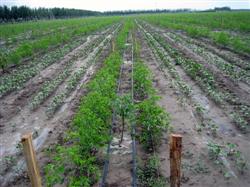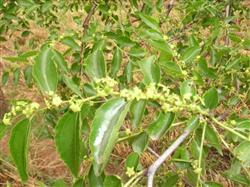"eat at the top door" for spring prevention of jujube trees

When jujube trees sprout in mid-late April, it is often found that the buds that have just grown are eaten by insects. This pest is jujube Buqu, which is called "eating at the neck door" in the bath. When the larvae crawl, the body is in the shape of a bow and creeps forward. When the jujube tree develops its leaves and blossoms, because the larvae grow up and the food intake increases greatly, the leaves are often eaten into large and small shortages, which can eat up the leaves and buds of the whole tree when it occurs seriously, which not only has no yield in the same year, but also affects the fruit setting in the coming year. Therefore, fruit growers should pay attention to its prevention and control. Before digging pupae in the middle of March, within 1 meter in diameter around the tree trunk, dig a soil layer of 15 cm deep to find winter pupae, and collect them outside the garden to destroy. This work can be carried out at the same time in combination with turning over trees. The female adult (female moth) of Jujube Buqu can not fly without wings. After Eclosion, it needs to climb the tree to find male moths to mate and lay eggs. According to this characteristic, a plastic film can be wrapped at the base of the trunk 30-50 cm from the ground before the adult Eclosion in mid-late March. The width of the film is 8-9 cm, the joint is 3 cm, and it is well fixed with two jujube thorns. The film should be close to the trunk without leaving a gap. This prevents the female from climbing up the tree to mate and lay eggs and catch the moth every morning. After the trunk of the egg-killing tree is wrapped with plastic film, the female moth cannot go up the tree and lay eggs in the rough skin cracks under the plastic film, which can pry open the rough skin and scrape the eggs, or wrap two circles of grass rope under the plastic film to induce the female moth to lay eggs, and change the grass rope every half a month and burn it centrally to destroy the eggs. Generally, you can change the straw rope three times. The newly hatched larvae of Zizyphus jujuba Buqu are pseudo-dead and droop immediately after being frightened, so knocking on the tree can shake down the larvae and destroy them in time. When the jujube bud is 3 cm long, the first time spraying, you can choose Bt emulsion 500-1000 times or 25% diflubenzuron 3 1500 times or jujube insects 1200 times to control newly hatched larvae. When the jujube buds are sprayed for the second time when the jujube bud is 5cm to 7cm, the jujube worm can be killed 1200 times with 1000 times of cypermethrin or 1000 times of phoxim 800~l000 with 1000 times of cypermethrin or 6000 times of cypermethrin to control all instar larvae. The larvae were captured artificially by making use of the habits of the static branches at noon to catch the residual mature larvae after spraying.
- Prev

Fertilizer and water management of jujube soil
Jujube trees have a long flowering period and like to be wet and afraid of dry. When 60% of the flowers are in full bloom, the jujube flowers can be evenly sprayed with water every 2-3 days for 2-3 times, which can increase the fruit setting rate. Spray 0.5% urea and 0.4% potassium dihydrogen phosphate or Tianrun No.1 solution every 5 to 7 days when jujube blossoms bloom for more than 3.
- Next

How to plant strawberries with high yield and good quality
Strawberries are planted in the greenhouse, and the environmental conditions of high temperature and humidity in the greenhouse are very conducive to the occurrence of various diseases and insect pests. Therefore, strengthening the comprehensive control of diseases is the key link to realize the high and stable yield of strawberries in greenhouse. First, leaf blight is mainly harmful to leaves, petioles, fruit pedicels, tender stems and sepals. Purplish brown is formed on the leaves.
Related
- Moge, come on! The staff of the peasant association in the producing area of cantaloupe were frightened when the crowd gathered.
- Causes and Solutions of low Fruit setting rate of Apple
- Symptoms and control measures of passion fruit virus disease
- Fruit growing lesson: how do apple orchards keep high yields?
- Can you build orchards in the mountains? What are the pros and cons?
- How to manage the coloring period of Crisson grape?
- This paper introduces the processing technology of two kinds of fig products.
- How much is a month for retired teachers in rural areas by 2020?
- How can strawberry planting increase sugar content? We should pay attention to management in many aspects.
- What are the cultivation techniques on how to improve the yield of golden fruit?

